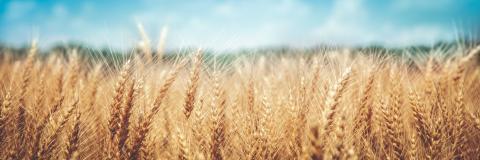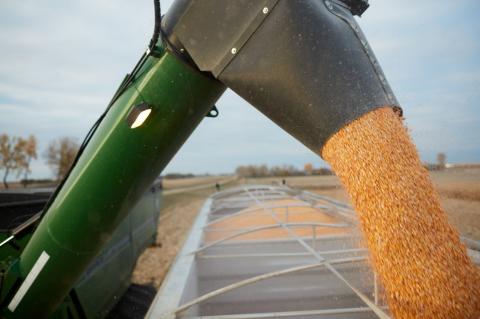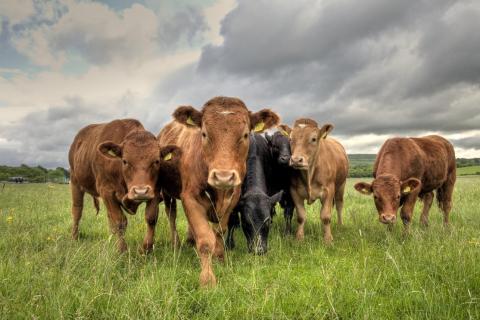18 June 2020
Dr Cate Williams: IBERS, Aberystwyth University.
- Homegrown crops present a financial and environmental advantage over bought-in concentrates and silage.
- There are many different options depending on farm location, land and soil type, type of enterprise and nutritional demands.
- For finishing beef cattle, metabolisable energy, protein and starch content are important nutrients to ensure good daily gains whilst minimising risk of ruminal acidosis.
- For some, finishing at grass may be an option. This presents a cheaper alternative to buying in, when pastures are well-managed using rotational grazing.
Over the past 20 years, UK livestock production has become more intensive, with more productive animals that require more nutrient-dense and protein rich feeds. As such, reliance on vegetable protein has increased. Soybean meal is generally thought of as the ‘gold standard’ in animal feeds, providing high levels of protein and energy for finishing and for milk production. However, UK arable agriculture is simply unable to meet the demand for soybean, mostly due to the temperate climate, so imported soybean has largely filled this gap. The UK now imports around 2 million tonnes of soybean per year, 90% of which is used in animal feeds and most of which originates from the US and South America. Whilst the growing of soybean, and indeed any other type of bean, is not problematic in itself, the scale on which it is produced does cause issues. Large monocultures result in a plethora of environmental issues – deforestation to clear space for planting, soil erosion and depletion, increased pesticide usage and increased greenhouse gas emissions from harvesting and transportation. As such, many UK farmers are now looking to homegrown crops, which not only reduce environmental impact but can have a significant effect on profitability, as bought in feeds constitute a large portion of many farms’ outgoings (approx. 75% in beef finishing systems). Such changes are being observed across a variety of industries, from poultry and pork to dairy and beef and have the potential to increase the sustainability of farming all round – this article will focus on the beef finishing industry.
So many options…
Barley
Barley is a popular crop in the UK and does well under temperature conditions. For ruminants, barley is the third most readily digestible cereal behind oats and wheat and offers high levels of starch and energy due to its rapid fermentation rate. The downside to high starch levels is, of course, ruminal acidosis. High-starch cereals, such as barley, are acid-producing, which in small quantities the rumen can cope with, but in larger quantities often fed in finishing systems the rumen cannot buffer itself. The rumen microbial population reduces in diversity, stability and fermentative capacity, depriving the animal of nutrients. The ruminant gut is not particularly well equipped to digest starch so grains may also accumulate in the ruminant’s intestines due to the lack of starch-degrading enzymes. This can promote the growth of pathogenic bacteria which can lead to serious health complications. Starch content and therefore fermentation rate, are variable depending on the barley cultivar. Therefore, it is important to note these differences so that farmers can select and feed the most appropriate varieties that optimize production without compromising rumen health.
Barley is a good source of crude protein and the essential amino acids, lysine, methionine and tryptophan (table 1). Cattle are unable to produce these amino acids for themselves so must receive them in the diet. Often the first limiting amino acids (those in shortest supply) are methionine, lysine and cysteine, of which barley offers higher amounts than maize or wheat. Barley is also lower in starch and fat when compared to maize and wheat (Table 1). However, barley can be low in vitamins and calcium and as such animals will require supplementation.
|
Nutrient |
Barley |
Maize |
Wheat |
|
Dry matter |
880 |
880 |
880 |
|
Crude protein (CP) |
115 |
88 |
135 |
|
Undegradable CP (g/kg CP) |
280 |
500 |
250 |
|
Neutral detergent fibre |
181 |
108 |
118 |
|
Acid detergent fibre |
60 |
30 |
40 |
|
Starch |
570 |
720 |
770 |
|
Fat |
19 |
38 |
22 |
|
Ash |
23 |
14 |
17 |
|
Lysine |
4.3 |
2.1 |
3.5 |
|
Methionine + Cysteine |
4.2 |
3.0 |
5.1 |
|
Tryptophan |
1.8 |
0.9 |
1.5 |
Table 1: Table 1: The nutrient composition of barley, maize and wheat as fed, Nikkhah, 2012.
Feeding management of barley is critical and inclusion level should be limited to maintain rumen health. It is also important to consider processing method, along with cultivar, as this will affect nutrient content. The main methods for processing barley in the UK are rolling or crimping, although barley may also be fed ‘whole’. Studies have shown that feeding whole barley reduced digestibility by approximately 48% and resulted in a large number of kernels being excreted in the faeces, indicating incomplete digestion. Processing greatly increases the nutritional value of barley as the fibrous hull cannot be sufficiently damaged during chewing which hampers access to key nutrients contained inside. The decision between crimping or rolling depends on the producer, although crimping may be more advantageous. Crimping barley offers the chance to harvest earlier (allowing earlier sowing of follow on crops) and eliminates the need for drying as the cereal is simply compacted into a clamp, similar to silage. The main drawback of crimping is that specialist equipment is required along with preservatives, however, this initial investment along with vitamin supplementation may be balanced out when the cost of bought-in feed is considered.
In 2020, 26 acres of barley was planted on the Farming Connect demonstration farm, Bodwi to investigate the effectiveness of crimping and inclusion in a finishing ration, with potential plans to grow and feed red clover silage. The site aims to reduce their bought-in feed costs which could help to increase the sustainability of the business and reduce their carbon footprint.
Wheat
In the UK, wheat is the largest arable crop by area, producing 14-16 million tonnes per year, supplying both the British milling industry and exporting a considerable amount overseas. As an animal feed, wheat is similar in its nutritional profile to barley, offering a low fibre, high energy and high starch grain. Wheat offers higher levels of starch compared to barley or maize, and as such ruminal acidosis is a common problem in cattle fed wheat (Table 1). Studies have found that whilst substituting barley grain with wheat does not affect overall digestibility, it does cause changes in the rumen microbial population, increasing the number of bacteria responsible for starch degradation and increasing the daily duration that rumen pH dipped below 5.8. Such evidence suggests that barley may be preferable over wheat in terms of rumen health or that wheat should be fed in careful moderation.
Like barley, wheat offers fair levels of crude protein and essential amino acids methionine and lysine as well as cysteine, however, the grain can be low in vitamins and calcium (Table 1). As such, wheat grain should be fed in moderation (40% or less) alongside good quality forage to avoid acidosis and with a vitamin supplement. Wheat must also be processed, generally rolled, to allow access to nutrients contained inside the husk. Early studies feeding unprocessed wheat found that feed intake increased by 18% and feed required per lb of gain increased by 15.8%, making whole wheat an expensive and inefficient feed. Extensive processing can also be detrimental, reducing the wheat to a floury consistency.
Maize
Maize may be fed as a crimped grain or as silage and is a popular feed for finishing beef cattle in the UK. However, not all parts of the UK are suitable for growing maize – the majority is grown in mid to Southern England and sheltered parts of Wales. As such, it is important to assess land in terms of location, soil type and altitude before selecting maize as a crop.
Nevertheless, maize offers a plethora of benefits, both economically and nutritionally. Like wheat and barley, maize is also high in starch and therefore energy, however, compared to barley, maize contains a larger amount of rumen-undegradable or by-pass starch. This means that approximately 35% of total starch cannot be degraded in the rumen and moves through to the small intestine instead. This results in a slower release of energy and the risk of ruminal acidosis is significantly reduced. However, maize contains slightly less protein than wheat or barley (9-10%) so will need to be balanced with another high-protein feed. A study by Harper Adams University investigated the performance of bulls finished on a barley-based diet versus crimped maize. The study found that those on crimped maize had larger daily live weight gains, were quicker to finish (141 vs. 154 days) and had higher slaughter weights (by 6 kg). Furthermore, those fed a maize-based diet had a lower incidence of liver abscesses, which can indicate ruminal acidosis. It is important to weigh the benefits and drawbacks of a feed, maize is a safer crop in terms of ruminal acidosis and offers good animal performance, but the economics of supplementing with additional protein should also be considered.
Another option for feeding maize is in the form of by-products – maize distiller’s grains or maize gluten feed. Both of these processing methods result in a product with higher crude protein levels (20-25%) whilst maintaining energy content. Maize distiller’s grains, in particular, offers highly digestible fibre and high levels of by-pass protein (or rumen undegradable protein). By-pass protein escapes the rumen and continues into the intestine where it can be absorbed for utilisation by the animal instead of the rumen microbiome. However, the nutrient profile of maize distiller’s grains can be highly variable and both sustainability and availability depends on geographical location. High oil levels can also limit inclusion, as fats should not exceed 5% of the ruminant diet. Again, it is important to weigh the benefits against the drawbacks and make a decision based upon each farm’s individual circumstances when selecting a feed.
Finishing on grass
An alternative to finishing beef cattle indoors on concentrates is to finish them out at pasture. Making use of good quality, highly digestible grass works out cheaper than bought-in feed and is achievable with good management and consideration for target markets. In summer, grass is generally plentiful with good grazing conditions and supplementary concentrates are rarely needed, however, supplementation during autumn may be necessary. In particular, heifers and native breeds are well adapted to finish on grass, but late-maturing, continental breeds may need supplementary concentrate feed. Stocking fields at a higher density during the spring and then reducing rates later in the season can help to maintain sward height and quality, especially in conjunction with rotational grazing methods. Nevertheless, autumn grass is still a more economical option than silage or concentrates and short-term concentrate supplementation reduces the requirement for more costly silage later on. Energy rather than protein is the limiting factor in autumn grass so using energy dense feeds is more important than those with high protein levels.
The ruminant diet can also affect the resulting products in terms of quality, composition and sensory attributes. Many studies report that the fatty acid profile of grazed meat, in particular, is different from that of cattle finished on concentrates. Whilst meat from these different diets is generally similar in saturated fat content (SFA), those fed on grass produce meat containing higher levels of health-beneficial polyunsaturated fats (PUFA), in particular, omega-3 and -6. Studies have found that the colour of meat from those finished on pasture is consistently darker, likely influenced by a combination of factors, including increased movement outdoors in the field. There is no consensus on the difference in taste between the two diets – as some claim that grass-fed tastes better than grain-fed, whilst others the opposite. However, there is a definite increase in consumer interest in grass-fed beef – perceived as having higher welfare standards and potential health benefits. As such, consumers are willing to pay a premium.
Legumes
To boost the protein content of pasture and/or silage a legume may be considered. Legumes can also boost dry matter intakes and offer the added benefit of being able to fix nitrogen. Atmospheric nitrogen is captured and converted by symbiotic bacteria in the roots into a usable form for the plant. This equates to 100-150 kg N/ha/yr for a white clover mix and 150-250 kg N/ha/yr for red clover mixes, reducing the need for nitrogen fertiliser which confers both economic and environmental benefits.
Perhaps the most popular legumes for use in livestock are red and white clover. Both species offer higher protein levels when compared to perennial ryegrass (PRG) and white clover contains higher amounts of minerals, magnesium, calcium, phosphorous, copper and selenium. Red clover also produces the enzyme polyphenol oxidase (PPO) which works to protect the protein stored in the plant, this is particularly useful in silages which contain higher quality and higher levels of protein than a PRG silage (14-19% versus 13.8%, respectively). Mixes containing red clover consistently produce higher yields than PRG alone when cutting for silage and tend to outperform white clover in this regard. As such, many sources recommend white clover for grazing and red clover for silage. Clover mixes and plantain have been shown to improve forage intake when compared to perennial ryegrass (PRG) monocultures, showing a linear relationship between % clover and dry matter intake (DMI). In general, the recommended inclusion rate for white clover when grazing dairy cows is 30%, and further research to determine optimum rates for beef cattle would be beneficial.
There are two key drawbacks to the use of red clover in grazing or silage, the first is that it is a short-lived crop, lasting 3 - 4 years, however, white clover may last up to 10 years with good management. The second is the risk of bloat which is caused by the rapid breakdown of protein from grazed clover resulting in a build-up of gas internally. As the rumen distends it exerts pressure on other internal organs, especially the lungs. However, with good management the risk of bloat can be greatly reduced – by limiting access when livestock are first turned out, offering extra fibre such as hay or straw or by feeding anti-bloat supplements. The risk of bloat from red clover silage, on the other hand, is negligible. Overall, the inclusion of clovers in grazing or silage has many potential benefits, for animal performance, for the environment and for the profitability of a farm business.
Summary
As increasing pressure is placed on UK farmers to become more efficient and productive whilst reducing their environmental impact, many are looking to reduce their bought-in feed consumption. As a result, some are considering planting their own feed crops – be that cereals or grasses for silage or grazing. Homegrown crops have the potential to reduce farmer’s carbon footprints by eliminating import activities and greenhouse gases associated with transport; this change may also contribute to reducing environmental issues in the exporting country. Additionally, whilst there will be an initial investment, growing and harvesting at home is more economically viable than buying in feed. Regardless, there is still the question of which crop to choose. Whilst this will depend on many other factors, animal nutrition is likely a key consideration. Especially in the case of beef finishing, metabolisable energy and protein content are key feed components, although starch should also be considered. Balancing the amount of starch in feed to provide enough energy and ensure good daily weight gain whilst minimising the risk of acidosis is essential. It may also be worth considering the individual amino acids in a feed – as essential amino acids are a valuable feed component. There may also be potential to finish from grass, although as autumn approaches, and particularly for continental breeds, supplementary concentrates may be necessary. Nevertheless, when well-managed, finishing on grass presents a cheaper alternative to bought-in concentrates and silage, particularly in light of increased consumer interest in grass-fed beef.



